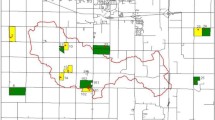Summary
One means of using infrared measurements of foliage temperature (T f ) for scheduling irrigations requires the use of meteorological data to predict the foliage-air temperature difference for a comparable well-watered crop (T * f − T a ). To determine the best method for making this prediction, parameters for models of increasing complexity for predicting (T * f − T a ) were derived for wheat using two sets of field data collected in 1982 and 1983.
The simplest model with vapor pressure deficit (VPD) as the sole predictor accounted for 64% of observed variance in (T * f − T a ). The next model with both VPD and net radiation (R n ) as predictors accounted for 74%. The most complex model predicted (T * f − T a ) from the crop energy balance. In addition to VPD and R n it included parameters for the effects of air temperature (T a ), aerodynamic resistance (r a ) and the canopy resistance of a well-watered crop (r cp ) and accounted for 70% of the variance.
Accuracy of these alternative models was tested against an independent set of field data collected in 1984. The single variable model with VPD as sole predictor accounted for 17% of the variance in observed values of (T * f − T a ). This increased to 47% when the effect of R n was included by using the two variable model and was increased further to 65% when the additional variables of T a , r a and r cp were included by use of the energy balance model. When the complexity of the model was measured by its number of variables there was a close relationship between complexity and the accuracy of the predictions. Reasons for the residual variability are discussed. The need for improved instrumentation for meteorological measurements was indicated.
Similar content being viewed by others
References
Butler BE (1979) Soil survey of the horticultural soils in the Murrumbidgee Irrigation Area of NSW. CSIRO Bull. No 289 (Revised edition of Bull. No 118 (1938) by JK Taylor and PD Hooper)
Ehrler WL (1973) Cotton leaf temperatures as related to soil water depletion and meteorological factors. Agron J 65:404
Feldhake CM, Boyer DG (1985) Resistance to waterloss from warm and cool season forage canopies in a growth chamber. Agric For Meteor 34:269
Hatfield JL, Pinter PJ Jr, Chasseray E, Ezra CE, Reginato RJ, Idso SB and Jackson RD (1984) Effects of panicles on infrared thermometer measurements of canopy temperature in wheat. Agric For Meteorol 32:97–105
Hatfield JL (1985) Wheat canopy resistance determined by energy balance techniques. Agron J 77:279
Idso SB, Jackson RD, Reginato RJ (1977) Remote sensing of crop yields. Science 196:19
Idso SB, Jackson RD, Pinter PJ, Reginato RJ, Hatfield JL (1981) Normalising the stress-degree-day parameter for environmental variability. Agric Meteorol 24:45
Idso SB, Reginato RJ (1982) Heat diffusion resistance and photosynthesis in cotton as related to foliage temperature based plant stress index. Agric Meteorol 27:27
Idso SB (1982) Non-water-stressed baselines: A key to measuring and interpreting plant water stress. Agric Meteorol 27:59
Jackson RD, Idso SB, Reginato RJ, Pinter PJ (1981) Canopy temperature as a crop water stress indicator. Water Resour Res 17:1133
Jackson RD (1982) Canopy temperature and crop water stress. Adv Irrig 1:43
Linacre ET (1968) Estimating the net-radiation flux. Agric Meteorol 5:49
Monteith JL (1973) Environmental physics. Edward Arnold, London, p 241
O'Toole J, Hatfield JL (1983) Effect of wind on the crop water stress index derived by infrared thermometry. Agron J 75:222
Smith RCG, Barrs HD, Steiner JL, Stapper M (1985 a) Relationship between wheat yield and foliage temperature: Theory and its application to infrared measurements. Agric For Meteorol 36:129
Smith RCG, Steiner JL, Meyer WS, Erskine D (1985 b) Influence of season to season variability in weather on irrigation scheduling of wheat: A simulation study. Irrig Sci 6:241–251
Steiner JL, Smith RCG, Meyer WS, Adeney JL (1985 a) Water use, foliage temperature and yield of irrigated wheat in south eastern Australia. Aust J Agric Res 36:1
Walker GK, Hatfield JL (1983) Stress measurement using foliage temperatures. Agron J 75:623
Wanjura DF, Kelly CA, Wendt CW, Hatfield JL (1984) Canopy temperature and water stress of cotton crops with complete and partial ground cover. Irrig Sci 5:37
Zadoks JC, Chang TT, Kouzak CF (1974) A decimal code for the growth stages of cereals. Weed Res 14:415
Author information
Authors and Affiliations
Rights and permissions
About this article
Cite this article
Smith, R.C.G., Barrs, H.D. & Steiner, J.L. Alternative models for predicting the foliage—Air temperature difference of well irrigated wheat under variable meteorological conditions. I. Derivation of parameters II. Accuracy of predictions. Irrig Sci 7, 225–236 (1986). https://doi.org/10.1007/BF00270432
Received:
Issue Date:
DOI: https://doi.org/10.1007/BF00270432




